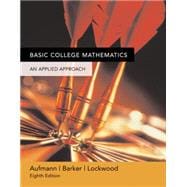
What is included with this book?
| Chapters 2–6 are followed by Cumulative Review Exercises | |
| Whole Numbers | |
| Introduction to Whole Numbers | |
| Addition of Whole Numbers | |
| Subtraction of Whole Numbers | |
| Multiplication of Whole Numbers | |
| Division of Whole Numbers | |
| Exponential Notation and the Order of Operations Agreement | |
| Prime Numbers and Factoring | |
| Focus on Problem Solving: Questions to Ask Projects and Group Activities: Order of Operations, Patterns in Mathematics, Search the World Wide Web | |
| Fractions | |
| The Least Common Multiple and Greatest Common Factor | |
| Introduction to Fractions | |
| Writing Equivalent Fractions | |
| Addition of Fractions and Mixed Numbers | |
| Subtraction of Fractions and Mixed Numbers | |
| Multiplication of Fractions and Mixed Numbers | |
| Division of Fractions and Mixed Numbers | |
| Order, Exponents, and the Order of Operations Agreement | |
| Focus on Problem Solving: Common Knowledge Projects and Group Activities: Music, Construction, Fractions of Diagrams | |
| Decimals | |
| Introduction to Decimals | |
| Addition of Decimals | |
| Subtraction of Decimals | |
| Multiplication of Decimals | |
| Division of Decimals | |
| Comparing and Converting Fractions and Decimals a fraction | |
| Focus on Problem Solving: Relevant Information Projects and Group Activities: Fractions as Terminating or Repeating Decimals | |
| Ratio and Proportion | |
| Ratio | |
| Rates | |
| Proportions | |
| Focus on Problem Solving: Looking for a Pattern Projects and Group Activities: The Golden Ratio, Drawing the Floor Plans for a Building, The U.S. House of Representatives | |
| Percents | |
| Introduction to Percents | |
| Percent Equations: Part 1 | |
| Percent Equations: Part II | |
| Percent Equations: Part III | |
| Percent Problems: Proportion Method | |
| Focus on Problem Solving: Using a Calculator as a Problem-Solving Tool, Using Estimation as a Problem-Solving Tool Projects and Group Activities: Health, Consumer Price Index | |
| Applications for Business and Consumers | |
| Applications to Purchasing | |
| Percent Increase and Percent Decrease | |
| Interest | |
| Real Estate Expenses | |
| Car Expenses | |
| Wages | |
| Bank Statements | |
| Focus on Problem Solving: Counterexamples Projects and Group Activities: Buying a Car | |
| Statistics and Probability | |
| Pictographs and Circle Graphs | |
| Bar Graphs and Broken-Line Graphs | |
| Histograms and Frequency Polygons | |
| Statistical Measures | |
| Introduction to Probability | |
| Focus on Problem Solving: Inductive Reasoning Projects and Group Activities: Deceptive Graphs; Collecting, Organizing, Displaying, and Analyzing Data | |
| U.S. Customary Units of Measurement | |
| Length | |
| Weight | |
| Capacity | |
| Time | |
| Energy and Power | |
| Focus on Problem Solving: Applying Solutions to Other Problems Projects and Group Activities: Nomographs, Averages | |
| The Metric System of Measurement | |
| Length | |
| Mass | |
| Capacity | |
| Energy | |
| Conversion Between the U.S. Customary and the Metric Systems of Measurement | |
| Focus on Problem Solving: Working Backward Projects and Group Activities: Name that Metric Unit, Metric Measurements for Computers | |
| Rational Numbers | |
| Introduction to Integers | |
| Addition and Subtraction of Integers | |
| Multiplication and Division of Integers | |
| Operations with Rational Numbers | |
| Scientific Notation and the Order of Operations Agreement | |
| Focus on Problem Solving: Drawing Diagrams Projects and Group Activities: Deductive Reasoning | |
| Introduction to Algebra | |
| Variable Expressions | |
| Introduction to Equations | |
| General Equations: Part I | |
| General Equations: Part II | |
| Translating Verbal Expressions into Mathematical Expressions | |
| Translating Sentences into Equations and Solving | |
| Focus on Problem Solving: From Concrete to Abstract Projects and Group Activities: Averages | |
| Geometry | |
| Angles, Lines, and Geometric Figures | |
| Plane Geometric Figures | |
| Area | |
| Volume | |
| The Pythagorean Theorem | |
| Similar and Congruent Triangles | |
| Focus on Problem Solving: Trial and Error Projects and Group Activities: Investigating Perimeter, Symmetry | |
| Table of Contents provided by Publisher. All Rights Reserved. |
The New copy of this book will include any supplemental materials advertised. Please check the title of the book to determine if it should include any access cards, study guides, lab manuals, CDs, etc.
The Used, Rental and eBook copies of this book are not guaranteed to include any supplemental materials. Typically, only the book itself is included. This is true even if the title states it includes any access cards, study guides, lab manuals, CDs, etc.